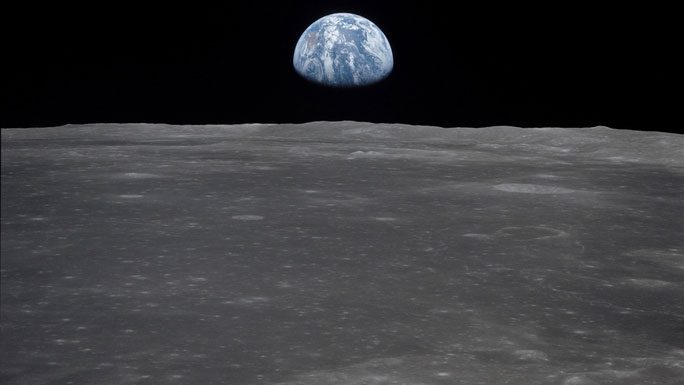A new study based on six meteorite fragments collected from Antarctica has unveiled more mysteries surrounding the hypothetical planet Theia, Earth, and the Moon.
According to Science Alert, these six meteorite fragments belong to a larger meteorite, originating from a volcanic plain on the Moon.
This type of rock is basalt that comes from magma within the Moon, which, after flowing out and cooling rapidly, was subsequently covered by multiple layers of basalt, thus preserving the primitive composition of Earth’s satellite.

Earth as seen from the Moon – (Photo: NASA)
The research team, led by space chemist Patrizia Will, who previously worked at ETH Zurich in Switzerland and is now at Washington University in St. Louis, USA, examined this type of rock at the ETH Zurich Noble Gas Laboratory.
They discovered tiny volcanic glass particles smaller than a millimeter within the meteorite, which perfectly retained isotopes of helium and neon, acting as “time capsules.” These hold evidence of ancient Earth’s winds. Since basalt has not been exposed to Earth’s winds, it must have originated from elsewhere.
Further analysis revealed that the isotopic ratio of neon closely resembles the isotopic ratio of neon found in Earth’s mantle, the layer beneath Earth’s crust, which contains materials that have undergone very little alteration since the planet formed 4.5 billion years ago.
This discovery provides additional evidence supporting the possibility that the Moon and Earth share a common origin, or in other words, the Moon is essentially a piece of Earth that broke away, wandered through space, and was then pulled back together by the planet’s gravity into a cohesive mass in orbit.
Factors related to Earth’s winds also lead to another intriguing concept – the hypothetical planet known as Theia.
Theia is named after the Greek goddess Theia, mother of the sun god Helios (the embodiment of Earth), the moon goddess Selene (the embodiment of the Moon), and the dawn goddess Eos.
For some time, there has been a hypothesis that Theia, the mysterious ninth planet of the early Earth system, roughly the size of Mars, collided with Earth during its formation. The two planets merged, and a portion of both broke apart, launched into orbit, and eventually coalesced into the Moon.
Thus, the new study presents striking evidence that further reinforces this hypothesis.
The reason scientists are seeking answers is the Moon’s anomalies. Most moons of other planets form from the gravitational pull of the planet “capturing” wandering rock masses in space, such as the potato-shaped moons of Mars.
Only Earth has a peculiar natural satellite, about 1/4 the size of the planet, with many unexplained uniformities. Therefore, the planetary science community increasingly believes that the Moon is actually a part of Earth’s ancient body.
This research has just been published in the scientific journal Science Advances.





















































